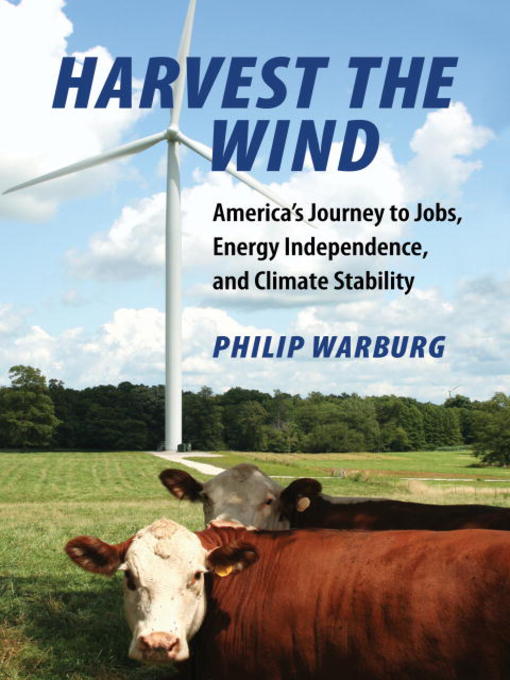
Harvest the Wind
America's Journey to Jobs, Energy Independence, and Climate Stability
کتاب های مرتبط
- اطلاعات
- نقد و بررسی
- دیدگاه کاربران
نقد و بررسی

January 2, 2012
Can wind power save us from our reliance on imported fossil fuel? Environmental attorney and activist Warburg believes so. In 2009, he set out to explore the question of how and where America could make wind energy happen, concentrating on the Meridian Way Wind Farm in Cloud County, Kans., where he spoke to landowners who rented out sections of their fields and pastures for turbine placement, educators who reshaped the local community college as a training center for wind energy technicians, and developers who worked with community partners. Today, only 3% of our electricity comes from wind, and there are significant difficulties to overcome: neighboring farms complain about aesthetics and noise; a $60 billion price tag for supplying 20% of our electricity from wind by 2030; and increasingly formidable foreign competitors. Though Warburg’s attitude toward the probability of energy independence is optimistic and his knowledge extensive, his language and presentation is dry and academic enough that—despite the worthiness of his cause—it’s difficult to imagine a commercial audience for this book. Agent: Colleen Mohyde, the Doe Coover Agency.

March 1, 2012
Warburg believes that that collaboration between the government and the private sector can make wind power a major source of energy for the generation of power in the United States. An attorney specializing in environmental law who served as president of the Conservation Law Foundation from 2003 to 2009, the author has been a committed environmentalist for more than 40 years. Warburg makes the case that with this "inexhaustible domestic energy resource," America can finally demonstrate a willingness to lead the international fight for climate stability. He reports on recent travels through the U.S. and in Denmark. where he met with "farmers, ranchers, shop owners, truckers, crane operators and more," whose lives have been improved by the new technology. He also visited large and small-scale wind farms, on land and offshore. While Warburg admits that wind power still presents serious problems for the environment--the turbines are responsible for the death of thousands of birds, the noise they produce can disturb neighboring residential communities, etc.--he is optimistic that these will be resolved and that the benefits of the new technology exceed the costs. At present, Danish investors are the leaders in turbine production. They outsource assembly production to China and the U.S., which rank first and second respectively in annual installations. The author writes that while American companies are only beginning to compete, they recognize that this is "the next big strategic bet." Citing a 2011 government report, Warburg estimates that Kansas alone could supply 90 percent of the nation's present power consumption with the installation of a sufficient number wind turbines. In 2010, seven percent of the state's energy needs have been met by wind power, providing up to $50,000 annually to farmers. Although Warburg summarily dismisses the potential of solar energy as a major part of the clean-energy mix, his arguments about wind power are balanced and informative.
COPYRIGHT(2012) Kirkus Reviews, ALL RIGHTS RESERVED.

February 1, 2012
First-time author Warburg (former president, Conservation Law Fdn.) briefly discusses the tumultuous history of wind power in the United States, while focusing on current projects and predicaments in wind energy, as well as some future possibilities. Warburg traveled to the Midwest to seek out current functioning wind farms. In his exploration of wind power, he also visited the Denmark wind turbine manufacturer Vestas and went to China. As the subtitle suggests, the book offers hope for the future of wind energy. Warburg writes about possible employment opportunities and the industry's power to revive depressed areas like the American Rust Belt or unused farmland. In his optimistic look toward the future, he is also grounded in his knowledge of the failures of the past and potential hazards of the present. VERDICT This text will appeal to the idealist and the environmental warrior, providing fuel for wind-power advocates by doing a hefty amount of surface-level research and footwork for them.--Dawn Lowe-Wincentsen, Oregon Inst. of Technology, Portland
Copyright 2012 Library Journal, LLC Used with permission.

February 15, 2012
With the rising threat of global warming and steady depletion of fossil fuels, the need to develop renewable energy resources is becoming ever more urgent. Warburg, an attorney specializing in environmental law, brings all his expertise to bear on one such green energy optionwind power. Motivated by his dismay at the government's reluctance to support wind-generated energy, Warburg found new reasons to be optimistic by visiting places where windmill arrays are thriving. His first stop was Cloud County, Kansas, where farmers profitably lease land to green energy developers and the area's Meridian Way Wind Farm is boosting the local economy. Other stops included Denmark, where one fifth of the country's energy needs are derived from wind, and China, which currently leads all nations in wind turbine production. In contrast to more politically and scientifically oriented books on alternative energy sources, Warburg's work takes reader to the human level, where wind power is making a real difference, and provides inspirational examples for other communities to follow.(Reprinted with permission of Booklist, copyright 2012, American Library Association.)

























دیدگاه کاربران